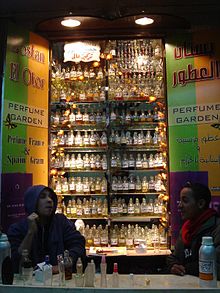Health and environmental issues

Perfume ingredients, regardless of natural or synthetic origins, may all cause health or environmental problems when used or abused in substantial quantities. Although
Health
Immunological
Evidence in peer-reviewed journals shows that some fragrances can cause asthmatic reactions in some individuals, especially those with severe or atopic asthma. Many fragrance ingredients can also cause headaches, allergic skin reactions or nausea.
In some cases, an excessive use of perfumes may cause allergic reactions of the skin. For instance, acetophenone, ethyl acetateand acetone while present in many perfumes, are also known or potential respiratory allergens. Nevertheless this may be misleading, since the harm presented by many of these chemicals (either natural or synthetic) is dependent on environmental conditions and their concentrations in a perfume. For instance, linalool, which is listed as an irritant, causes skin irritation when it degrades to peroxides, however the use of antioxidants in perfumes or reduction in concentrations can prevent this. As well, the furanocoumarin present in natural extracts of grapefruit or celery can cause severe allergic reactions and increase sensitivity to ultraviolet radiation.
Some research on natural aromatics have shown that many contain compounds that cause skin irritation. However some studies, such as IFRA's research claim that opoponax is too dangerous to be used in perfumery, still lack scientific consensus. It is also true that sometimes inhalation alone can cause skin irritation.
Carcinogenicity
There is scientific evidence that nitro-musks such as musk xylene can cause cancer while common ingredients, like certain polycyclicsynthetic musks, can disrupt the balance of hormones in the human body (endocrine disruption). Some natural aromatics, such as oakmoss absolutes, contain allergens and carcinogenic compounds.[
Toxicity
Certain chemicals found in perfume are often toxic, at least for small insects if not for humans. For example the compound Tricyclodecenyl allyl ether is often found in synthetic perfumes[ and has insect repellent property.
Environmental
Pollution
Synthetic musks are pleasant in smell and relatively inexpensive, as such they are often employed in large quantities to cover the unpleasant scent of laundry detergents and many personal cleaning products. Due to their large-scale use, several types of synthetic musks have been found in human fat and milk, as well as in the sediments and waters of theGreat Lakes.
These pollutants may pose additional health and environmental problems when they enter human and animal diets.
Species endangerment
The demands for aromatic materials like sandalwood, agarwood, musk has led to the endangerment of these species as well as illegal trafficking and harvesting.
Safety regulation
The perfume industry in the US is not directly regulated by the FDA, instead the FDA controls the safety of perfumes through their ingredients and requires that they be tested to the extent that they are Generally recognized as safe (GRAS). Due to the need for protection of trade secrets, companies rarely give the full listing of ingredients regardless of their effects on health. In Europe, as from 11 March 2005, the mandatory listing of a set of 26 recognized fragrance allergens was enforced.The requirement to list these materials is dependant on the intended use of the final product. The limits above which the allegens are required to be declared are 0.001% for products intended to remain on the skin, and 0.01% for those intended to be rinsed off. This has resulted in many old perfumes like chypres and fougère classes, which require the use of oakmoss extract, being reformulated.
Preserving perfume
Fragrance compounds in perfumes will degrade or break down if improperly stored in the presence of:
Proper preservation of perfumes involves keeping them away from sources of heat and storing them where they will not be exposed to light. An opened bottle will keep its aroma intact for several years, as long as it is well stored. However the presence of oxygen in the head space of the bottle and environmental factors will in the long run alter the smell of the fragrance.
Perfumes are best preserved when kept in light-tight aluminium bottles or in their original packaging when not in use, and refrigerated to relatively low temperatures: between 3-7°C (37-45°F). Although it is difficult to completely remove oxygen from the headspace of a stored flask of fragrance, opting for spray dispensers instead of rollers and "open" bottles will minimize oxygen exposure. Sprays also have the advantage of isolating fragrance inside a bottle and preventing it from mixing with dust, skin, and detritus, which would degrade and alter the quality of a perfume.
There exist several archives and museums devoted to the preservation of historical perfumes, namely the Osmothèque, which stocks over 3,000 perfumes from the past two millennia in their original formulations. All scents in their collection are preserved in non-actinicglass flasks flushed with argon gas, stored in thermally insulated compartments maintained at 12°C (53.6°F) in a large vault.
Lists of perfumes
Further information: List of Famous Perfumes
Further information: List of celebrity endorsed perfumes




ไม่มีความคิดเห็น:
แสดงความคิดเห็น